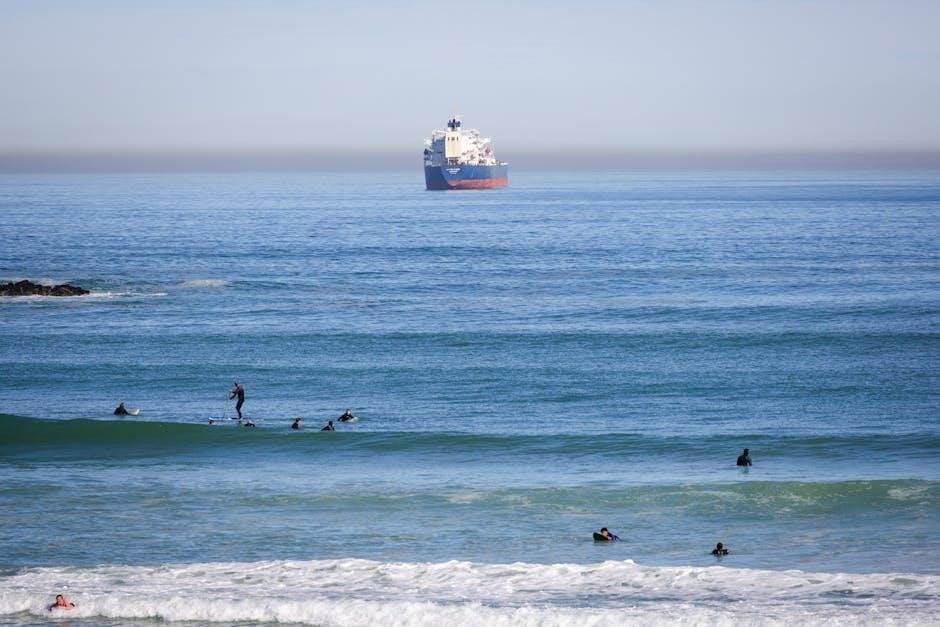Choosing the right surfboard is a crucial decision for every surfer, from beginners to experienced riders. It impacts performance, comfort, and overall surfing experience. With various options like soft tops, longboards, and high-performance shortboards, understanding your needs is key. Consider factors like skill level, budget, size, and eco-friendly materials to make an informed choice. Explore different types and constructions to find the perfect board that suits your style and wave conditions. Start your surfing journey with confidence by selecting the ideal surfboard tailored to you.
1.1 Why Choosing the Right Surfboard Matters
Selecting the right surfboard is vital for performance, safety, and enjoyment. It ensures proper buoyancy, stability, and maneuverability, matching your skill level and wave conditions. The wrong board can hinder progress, while the right one enhances your surfing experience. Consider size, volume, and material to find a board that supports your growth and surfing style, whether you’re a beginner or an advanced rider.
1.2 Brief Overview of Surfboard Types
Surfboards come in various types catering to different skills and preferences. Soft tops are ideal for beginners, offering safety and durability. Longboards provide stability and ease of catching waves. Shortboards are high-performance boards for advanced riders seeking speed and maneuverability. Funboards and hybrid options bridge the gap, offering versatility. Each type ensures a unique surfing experience tailored to individual needs and wave conditions.

Understanding Surfboard Types
Understanding surfboard types is essential for choosing the right board. From soft tops to longboards and shortboards, each design offers unique performance, stability, and maneuverability for different surfing styles.
2.1 Soft Top Surfboards
Soft top surfboards are perfect for beginners, offering a lightweight, foam construction that provides excellent buoyancy and stability. Their soft, durable surface ensures safety, reducing the risk of injury. Ideal for kids, teenagers, and new surfers, these boards feature detachable fins and a safety leash for added convenience. They are easy to handle, making them a great choice for learning the basics of surfing. Their lightweight design also makes them easy to transport and store, while their affordable price point suits those just starting their surfing journey.
2.2 Longboard Surfboards
Longboard surfboards, typically ranging from 8 to 14 feet, are known for their stability and ease of catching waves. Their larger size provides excellent buoyancy, making them ideal for cruising and carving. Suitable for all skill levels, longboards are perfect for both beginners and experienced surfers. They offer a classic surfing experience with smooth, flowing rides, making them a popular choice for those who enjoy traditional surf culture and versatile wave conditions.
2.3 Shortboard Surfboards
Shortboard surfboards, typically between 5 and 7 feet, are designed for high-performance surfing. Their rounded noses and squared tails offer exceptional maneuverability and speed, making them ideal for advanced surfers. Best suited for intermediate to expert riders, shortboards excel in various wave conditions, from tight turns to powerful waves. They provide a dynamic and responsive ride, perfect for those seeking precision and control in the water.
2.4 Funboard Surfboards
Funboard surfboards are versatile, blending the stability of longboards with the maneuverability of shortboards. Typically ranging from 7 to 8 feet, they are ideal for intermediate surfers seeking a balance between performance and ease. Their rounded noses and squared tails provide a forgiving yet responsive ride, making them suitable for various wave conditions. Funboards are perfect for progressing skills while maintaining fun and control in the water.
2.5 Hybrid and Specialty Boards
Hybrid and specialty boards combine elements from multiple surfboard types, offering unique performance for specific needs. These boards cater to diverse surfing styles, from big wave riding to high-performance maneuvers. They often feature innovative designs, such as asymmetrical shapes or eco-friendly materials. Surfers seeking customization can opt for hand-shaped boards from expert shapers, ensuring a tailored fit for their preferences and skills.
Key Considerations Before Buying
Assess your skill level, budget, and size requirements. Consider volume for buoyancy and stability. Eco-friendly materials and construction quality are also important factors to evaluate carefully.
3.1 Skill Level and Experience
Your skill level significantly influences the right surfboard choice. Beginners benefit from soft-top surfboards due to their forgiveness and soft surfaces, reducing injury risks. Intermediate surfers often transition to funboards or longboards, offering stability while improving maneuverability. Advanced riders may prefer shortboards for high-performance surfing. Always match your board to your experience for optimal progress and enjoyment in the water.
3.2 Height, Weight, and Balance
Your height, weight, and balance play a crucial role in selecting the right surfboard. Taller surfers may prefer longer boards for stability, while shorter riders benefit from shorter, more maneuverable options. Weight influences the required volume for buoyancy, with heavier surfers needing more volume. Balance is enhanced by a board’s width and thickness, ensuring stability and ease of control in the water.
3.3 Budget and Price Range
Setting a budget is essential when buying a surfboard, as prices vary widely. Soft Top surfboards can start around $200-$400, while high-performance boards may exceed $1,000. Consider used boards for cost savings. Additional costs include fins, leashes, and wax. Plan your budget carefully to ensure you get a board that meets your needs without overspending. Higher-priced boards often offer better performance but aren’t always necessary for beginners.
Choosing the Right Size and Volume
Size and volume are critical for performance and buoyancy. Longer, thicker boards offer stability for beginners, while shorter, thinner boards suit experienced riders seeking maneuverability. Match your weight and skill level to the board’s dimensions and volume for optimal results in various wave conditions.
4.1 Length, Width, and Thickness Explained
Length affects stability and maneuverability, with longer boards offering more glide and shorter boards enabling tighter turns. Width impacts buoyancy and ease of catching waves, while thickness influences floatation. Thicker boards are more forgiving, suited for beginners. Narrower, thinner boards provide speed and responsiveness for advanced riders. Dimensions vary across surfboard types, ensuring a tailored fit for skill levels and wave conditions.
4.2 Volume and Buoyancy for Different Surfers
Volume and buoyancy are critical for matching surfers’ needs. Higher volume boards provide better floatation, ideal for beginners or heavier riders needing stability. Lower volume boards suit advanced surfers seeking speed and agility. Buoyancy ensures the board stays afloat, while volume distribution affects performance in different wave conditions. Balancing these factors ensures optimal surfing efficiency and enjoyment for all skill levels and body types.
4.3 How to Measure Your Ideal Board Size
To determine your ideal board size, consider your height, weight, skill level, and riding style. Stand against a wall to measure your height and compare it to standard board lengths. Beginners often prefer longer, more buoyant boards for stability, while experienced riders may opt for shorter, more maneuverable options. Consult size charts or seek expert advice for a precise fit.
Surfboard Construction Materials
Surfboards are made from materials like foam, fiberglass, epoxy, and carbon fiber. Foamies offer soft, durable options for beginners, while fiberglass and epoxy provide strength and performance.
5.1 Foamie (Soft Top) Construction
Foamie surfboards, or soft tops, are made from lightweight, soft foam with a durable outer layer, making them ideal for beginners and kids. They are safer and more forgiving, reducing the risk of injury. Many soft top boards feature detachable fins and a soft traction pad for better grip. Their buoyancy and stability make them perfect for learning to catch and ride waves with confidence.
5.2 Fiberglass and Epoxy Boards
Fiberglass surfboards are durable and lightweight, combining a foam core with layers of fiberglass for strength. Epoxy boards are similar but use epoxy resin, offering better resistance to dings and fading. Both are popular for their performance in various wave conditions, making them suitable for intermediate to advanced surfers seeking a balance of speed, maneuverability, and reliability in the water.
5.3 Carbon Fiber and High-Performance Materials
Carbon fiber surfboards are built for elite performance, combining lightweight, high-strength materials with advanced construction techniques. These boards deliver exceptional speed, pop, and responsiveness, ideal for advanced surfers. High-performance materials like carbon fiber and advanced composites offer superior durability and flexibility, making them a top choice for professionals seeking cutting-edge technology and precision in their surfing experience.

Additional Equipment You’ll Need
Beyond the surfboard, essential gear includes fins for stability, a leash to keep your board nearby, wax for traction, a rash guard for protection, and a board bag for transportation.
6.1 Fins and Fin Setup
Fins are crucial for stability, control, and maneuverability. Common setups include single fins for classic longboards, twin fins for speed, and thruster setups for high performance. Soft top boards often come with detachable fins for safety, while high-performance boards may use glass-on or box fins. The setup and material significantly impact your surfing experience.
6.2 Leash and Rash Guard
A leash keeps your surfboard attached, preventing loss and potential hazards. Choose a durable, high-quality leash suitable for your board size. A rash guard protects against sun, wind, and chafing, with UPF ratings for sun protection. Both essentials enhance safety, comfort, and performance while surfing. Opt for a rash guard with breathable, quick-drying fabric and a leash with a reliable ankle strap.
6.3 Wax and Traction Pads
Wax provides essential grip on your surfboard, preventing slipping while surfing. Apply it evenly for optimal traction. Traction pads offer a textured surface, enhancing balance and control. Both are vital for maintaining stability and confidence in the water. Choose high-quality wax and pads designed for your board type to ensure durability and performance during your sessions.

Where to Buy Your Surfboard
Explore local surf shops for expert advice or online retailers like Surf Station Store, Boardcave, and Amazon for a wide selection. Compare deals on new and used boards, ensuring quality and suitability for your needs. Both options offer convenience and access to top brands and models.
7.1 Local Surf Shops vs. Online Retailers
Local surf shops offer personalized advice, hands-on board testing, and immediate feedback from experienced staff. Online retailers provide convenience, wider selections, and competitive pricing. Both options cater to different needs: shops for tactile experiences and online for variety and deals. Consider preferences for in-person guidance versus broader choices and home delivery when deciding where to purchase.
7.2 What to Look for in a Surf Shop
A reputable surf shop should offer a wide selection of boards, experienced staff for expert advice, and a supportive environment for all skill levels. Look for shops with positive reviews, knowledgeable teams, and additional services like repairs or workshops. Ensure they cater to your specific needs, whether you’re a beginner or an advanced surfer seeking high-performance gear.
7.3 Buying New vs. Used Surfboards
Buying new ensures access to the latest technology, warranties, and customization options, while used boards offer cost savings and environmental benefits. New surfboards come with warranties and are free from damage, but are more expensive. Used boards are budget-friendly and eco-friendly but may require inspections for dings or wear. Consider your budget, preferences, and needs when deciding between new and used options.

Maintenance and Care
Regular cleaning, proper storage, and protection from the elements are essential to extend your surfboard’s life. Avoid exposure to direct sunlight and saltwater damage to maintain its condition.
8.1 Cleaning and Storing Your Board
Regularly rinse your surfboard with fresh water to remove salt and debris. Use a soft cloth and mild soap for deeper cleaning. Always store it in a cool, dry place, away from direct sunlight. Avoid leaning it against sharp objects or leaving it in a hot vehicle to prevent damage. Proper care ensures longevity and maintains performance.
8.2 Repairing Dings and Damage
Assess the damage to determine the best repair method. Small dings can be fixed with surfboard resin and cloth, while deeper cracks may require professional attention. Use a repair kit to fill and sand minor scratches. For severe damage, consult a skilled shaper or repair specialist to restore your board’s integrity and performance. Act quickly to prevent further deterioration.
8.4 Protecting Your Board from the Elements
Shield your surfboard from UV exposure with a UV-resistant bag or wax. Store it in a shaded, cool place to prevent warping. Rinse with fresh water after use to remove salt and debris. Use a protective cover or bag when not in use to avoid dings and scratches. Regular maintenance ensures longevity and keeps your board in prime condition.
Safety Tips for Beginners
Always check wave conditions and learn basic water safety. Wear a leash to keep your board attached and use a rash guard for protection. Stay aware of your surroundings and follow surfing etiquette to avoid collisions.
9.1 Understanding Wave Conditions
Understanding wave conditions is vital for safe and enjoyable surfing. Learn to identify wave height, shape, and strength to match your skill level. Small, gentle waves are ideal for beginners, while experienced surfers can tackle larger, more powerful waves. Always check the forecast and observe the surf before entering the water to ensure a safe and enjoyable experience.
9.2 Safety Gear for Beginners
Safety gear is essential for beginners to protect themselves and others in the water; A leash keeps your board attached, preventing it from injuring others or getting lost. A rash guard offers sun protection and reduces friction. Soft-top surfboards with soft fins are ideal for beginners, minimizing injury risks. Always wear proper gear to ensure a safe and enjoyable surfing experience.
9.3 Etiquette in the Water
Etiquette in the water is crucial for a positive surfing experience. Always respect other surfers, yielding to those on the inside. Avoid dropping in on others and never paddle in front of someone riding a wave. If you collide, apologize promptly. Respect locals and the environment by not littering. Following these rules ensures harmony and safety for everyone in the water.
Budgeting for Your Surfboard
Average surfboard prices range from $100 for soft tops to over $1,000 for high-performance boards. Set a budget considering your needs, skill level, and brand preferences.
10.1 Average Price Ranges
Surfboard prices vary widely, with soft tops starting around $100-$400, while longboards range from $500-$1,200. Shortboards typically cost $600-$1,500, and funboards fall between $500-$1,000. High-performance boards can exceed $1,200-$2,000. Prices depend on materials, brand, and quality, making it essential to balance budget with desired performance and durability for your surfing needs.
10.2 Hidden Costs (Wax, Fins, Lessons)
Beyond the surfboard, additional costs include wax ($5-$10), fins ($20-$100), and leashes ($10-$30). Lessons can range from $40-$100 per session, while a full set of safety gear adds up. Budgeting for these extras ensures you’re fully equipped and prepared to hit the waves without unexpected expenses. Plan ahead to cover all necessary items for a seamless surfing experience.
10.3 Financing Options and Payment Plans
Many surf shops and online retailers offer financing options or payment plans to make buying a surfboard more affordable. Some provide zero-interest plans or flexible installments. Additionally, certain brands or stores offer discounts for upfront payments. Always inquire about available financing options to find a plan that fits your budget and helps you own your ideal surfboard without financial strain.
Environmental Considerations
Eco-friendly surfboard options are gaining popularity, with sustainable materials and production methods reducing environmental impact. Choose boards made from recycled or biodegradable materials to support greener manufacturing practices.
11.1 Eco-Friendly Surfboard Materials
Eco-friendly surfboard materials include recycled foam, bamboo, and plant-based resins, reducing environmental impact. Sustainable options like bio-based epoxy and FSC-certified wood are gaining popularity. These materials lower carbon footprints while maintaining performance, making them ideal for environmentally conscious surfers who prioritize both quality and sustainability in their surfing journey.
11.2 Sustainable Surfboard Brands
Brands like Channel Islands and Firewire lead in sustainable surfboard production, using eco-friendly materials. Firewire’s Timbertek and Michel Junod’s recycled foam boards reduce environmental impact. These brands prioritize sustainability without compromising performance. Eco-conscious surfers can support these initiatives, aligning with their values while enjoying high-quality, responsibly made surfboards that minimize ecological footprints.
11.3 Recycling and Disposing of Old Boards
Recycling or responsibly disposing of old surfboards is essential to reduce environmental impact. Donate usable boards or repurpose them creatively. Many surf shops offer recycling programs, though options are limited. If recycling isn’t available, ensure proper disposal through local waste management. Consider supporting eco-friendly brands that use recycled materials to promote sustainability in the surfing community.
